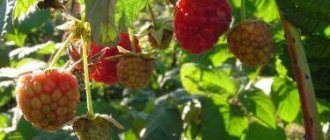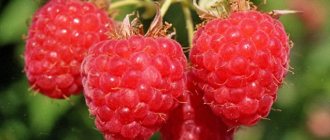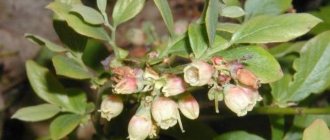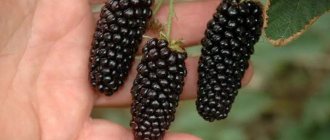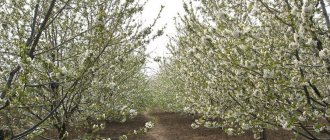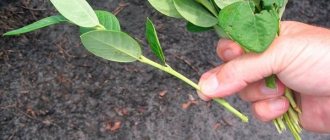Description of the Moscow Giant raspberry variety
The name of the variety corresponds to its characteristics. Large-fruited raspberry Moscow giant is a tall shrub-type plant. Its shoots exceed a height of two meters. Powerful stems are mostly erect, with apices leaning towards the ground. The bark is brown or brown-brown. There are no thorns on the shoots, which makes the variety even more attractive in the eyes of gardeners.
Moscow giant raspberry produces large leaves with a rounded base and a sharp triangular tip. The outer side of the leaf blade is glossy, dark green. The inner surface has a light green tint.
Moscow giant raspberries are semi-remontant varieties. In theory, this means that it can produce two harvests per summer. However, this statement has not been confirmed by practice. In the southern regions, it is actually possible to harvest two crops per season. First, last year's shoots bear fruit abundantly. Towards the end of summer, the stems of the current year also begin to bear fruit, but only on their upper third. In the middle zone it is rarely possible to collect a second full harvest of berries.
Attention!
Moscow giant raspberries are characterized by an average degree of shoot formation - up to 4-5 young shoots during one season.
The Moscow Giant raspberry is not zoned, and the conditions for its cultivation can only be judged by the reviews of gardeners. Today it is most popular in the central and northwestern regions of Russia.
Like most varieties of this berry crop, Moscow giant raspberries prefer to grow in sunny areas protected from wind and drafts with rich soils. However, it is possible to organize the cultivation of Moscow giant red raspberries on loamy or sandy loam soils. The main thing is to feed the bushes on time.
Moscow giant raspberries in the photos taken by gardeners fully confirm the name of the variety. The berries are very large, conical in shape. They can reach a weight of 25-30 grams. Raspberries are distinguished by their bright pink hue and increased fruit density. They do not fall off the branches when ripe and retain their shape when harvested.
Raspberries of the Moscow Giant variety tolerate hot and sunny weather well. Its fruits do not bake in the sun, and the bushes themselves can go without watering for a short time without losing the yield and taste of the fruit.
It is currently unknown how many points out of a possible five the Moscow Giant raspberry gets according to the tasting assessment. But it is a proven fact that its bright sweet taste is highly valued by gardeners and chefs.
Caring for raspberries
Strawberry Moscow Delicacy - variety description
Even taking into account the fact that the Moscow Giant raspberry is considered an unpretentious variety, high-quality care of the bushes is the key to good survival rate and productivity.
Interesting. The most important thing is to keep the soil moist.
Naturally, watering raspberry bushes will depend on climatic and natural features. During hot and dry periods, Gigantella should be watered abundantly once every 2-3 days. But if the weather is favorable with frequent and prolonged precipitation, then watering is carried out from 1 to 3 times a month, while focusing on the condition of the soil. Excessive stagnation of moisture is not welcome, as it slows down the development of the root system of the bush.
In summer, when the sun is hot, raspberries should be watered only in the evening to avoid overheating and sunburn on the plant.
Characteristics of the Moscow Giant raspberry variety
Reviews from gardeners say that the M. Giant variety tolerates frosts down to –30˚C well under snow or light shelters. In addition, it recovers well after light freezing of the shoots. Flowers also do not die during slight return frosts, which is very important, since the first inflorescences appear on the shoots already in the second half of May.
Also, the Moscow giant raspberry tolerates dry weather well, only periodically requiring abundant watering. With a short-term lack of moisture, raspberry fruits do not dry out, do not mummify or crumble.
Features of fruiting
Raspberry Moscow giant (giant) is an early ripening variety. The first berries from two-year-old shoots can be collected at the end of June. The first peak of fruiting occurs in the first half of July. Whether raspberries will bear fruit on the stems of the current season and how abundantly depends largely on weather conditions and the region of growth.
In warm weather, with a lot of sunny days, Moscow giant raspberries will delight gardeners with a second harvest in mid-to-late August. But even with little flowering, berries will form until mid-September. True, in small quantities.
With double fruiting per season and regular feeding, Moscow giant raspberries will delight you with a yield of 10-12 kilograms per bush. With scanty second fruiting or its absence, you can get at least 6-8 kilograms from one plant. Which is also very good. Moscow giant raspberries are distinguished by good keeping quality and transportability. Freshly picked berries can be stored at room temperature for at least three days. In the refrigerator, the time increases to 10 days.
Raspberries of the Moscow Giant variety are universal in use. Fresh berries are very good and rich in vitamins. They tolerate freezing well. When defrosted, they retain their taste and shape and will delight you in a variety of desserts. Raspberries contain a small amount of small seeds, so jams and jams made from them are especially tender.
Interesting fact!
Raspberries are an excellent diaphoretic. In addition, it is rich in vitamin C. Decoctions of dried berries and young shoots are an excellent medicine that will help reduce fever and strengthen the immune system in case of viral diseases.
"Pros and cons"
Currently, the Moscow giant raspberry receives mostly positive reviews from gardeners due to its advantages:
- The variety is characterized by high productivity.
- Raspberries are unpretentious to growing conditions.
- Does not require careful care.
- It has good frost resistance and increased drought resistance.
- The berries do not fall off during ripening. They separate well from the stalk during harvesting and do not crumble during transportation.
- Raspberries have excellent taste and product characteristics.
- At the moment, Moscow giant raspberries are considered one of the best varieties with the highest immunity to almost all diseases.
Excellent yield
During the season, raspberries produce 10-12 kg of harvest. The fruit ripens in July. With proper care, the harvest can be harvested until mid-October. That is why the plant is often planted in large farms.
Raspberries of this variety have many advantages. It boasts large fruits and high yield parameters. To achieve success in growing crops, you need to water, feed and trim the bushes on time. The Moscow giant is just beginning to gain popularity in the country, but there is no doubt that this raspberry variety will find its fans among gardeners and farmers.
Features of reproduction
The Moscow Giant variety reproduces well by cuttings and layering. In the first case, in the fall, a ripened shoot is selected, cut off and cuttings 15-20 cm long with two or three buds are cut. In winter, cuttings can be stored in the cellar in a box with peat, covering them with damp moss. Or you can immediately plant them under good cover. In the spring, Giant Moscow raspberry seedlings are planted in the main place.
If there are plans to plant raspberries in the fall, then in early spring they dig in one of the shoots, leaving the top free. In September, the cuttings that have sprouted new shoots are carefully separated and planted.
Landing
The time for planting seedlings of the “Moscow Giant” in a permanent place is from the first ten days of spring to the beginning of autumn. The landing site must be protected from strong winds. It is best to choose areas where a sufficient level of snow cover can be provided in winter.
Key points that require special attention when preparing for planting the “Giant of Moscow”:
- one season before planting seedlings in the selected area, experienced gardeners recommend planting plants that have a positive effect on the mechanical characteristics of the soil: alfalfa, clover, vetch;
- the ideal soil for growing a plant should be neutral or slightly acidic, rich in organic components;
- To improve the quality characteristics of the soil, professionals advise using organic fertilizers;
- plant the “Giant of Moscow” in specially prepared trenches or planting holes;
- plants are planted in rows, the distance between which should be about 150 centimeters, retreating from obstacles (fences, buildings, structures) by 150–200 centimeters.
How to plant correctly
Raspberry seedlings of this variety are planted in mid-spring or early autumn. Both options have their pros and cons. When planted in spring, raspberries may be exposed to summer heat and will need regular watering. In the fall, raspberries may not have time to take root before the onset of cold weather. For the middle zone, planting raspberry bushes in the spring is more reliable.
Raspberries are a perennial plant, so you should be careful when choosing a location. They choose sunny places for the Moscow giant, protected from the wind, with fertile soil and the absence of underwater water. You should not plant Moscow giant raspberries in lowlands, where their roots may die from excess moisture.
Raspberries can grow both along a hedge and in rows on a kind of plantation. The main thing is to maintain a distance of 1.2-1.5 meters between the bushes.
Moscow giant raspberries are planted in trenches about 40 cm deep. First, the soil is generously fertilized with rotted compost. The seedlings are planted and sprinkled with soil so that the root collar remains at a height of 5-6 cm above the soil surface. The soil is compacted well and watered abundantly.
It is advisable to mulch the soil in a fairly thick layer. Peat should not be used as mulch. Weeds quickly grow through it, and the peat itself strongly oxidizes the soil. Raspberries prefer neutral acidity.
Landing
When breeding any large-fruited raspberry variety, the gardener must always remember that these hybrids do not really like winters, even if they tolerate 30 degree frosts well. Sudden changes of cold and thaw are dangerous for the plant.
You might be interested! Description of a standard raspberry variety with a yield of more than 6 kg. from the bush - Penguin raspberry.
High yields quickly deplete the soil. Therefore, before acquiring planting material, you need to prepare the site as follows:
- a site for the Gigant Moscow variety should be chosen that is well-lit, not blown by draft winds, preferably on a slope or on a hill. This way the roots will not get wet, and the berries will receive the maximum amount of sunlight;
- place the raspberry tree so that the existing fences on the site provide it with a high level of snow cover in winter to protect it from frost and changes in air temperature;
- the soil should be loamy or sandy loam, with weak or neutral acidity. Therefore, it is necessary in advance to bring the soil to the desired characteristics using peat, sand, humus, wood ash, and lime;
- Considering the great need for nutrients in large-fruited raspberry varieties, it is recommended to sow various green manures on the site a year before planting: mustard, clover, rye, alfalfa. They loosen the soil, nourish it with organic fertilizers, and rid the soil of pests. It would also be useful to bring fresh manure and forest soil to the site.
- prepare compost pits to constantly supply the raspberry fields with organic fertilizers.
Trenches or holes for planting seedlings are prepared 2-3 weeks before planting. You need to prepare a composition of fertilizers (humus, manure or bird droppings, wood ash, mineral fertilizers). Mix everything with soil and fill the holes one third with this mixture. During planting, the roots of the cuttings should be well straightened, carefully covered with garden or forest soil, watered and mulched at the planting site. The root neck of the cutting should be 1-2 cm in the ground. The cuttings are cut, leaving a length of 40-50 cm.
Growing rules
After planting, the Moscow Giant raspberry also needs appropriate care, which consists of performing the following activities:
- Watering is carried out as the soil dries. During the fruiting period, the amount of watering is increased.
- In spring, raspberries are fed generously with organic matter. You can add compost directly to the soil while loosening. Subsequently, fertilizing is carried out with complex fertilizers during the period of flowering and after harvesting.
- Regularly loosen the soil and add mulch.
Diseases and pests, methods of control and prevention
Giant Ruby is highly resistant to damage and attacks by pests. But you still need to take into account the placement of neighboring plants that can become spreaders of diseases.
Before the first flowering, it is necessary to carry out preventive treatment of the variety with insecticides. On hot days, carefully inspect the bushes so as not to miss the appearance of spider mites. It is combated by treating with colloidal sulfur. Among folk remedies, onion or garlic infusion is suitable (100 g of husks left for 3 days in 10 liters of water).
Common raspberry varieties can become a breeding ground for the raspberry beetle, which will move into Ruby Giant plantings. Control methods include digging up the soil and treating plants with appropriate preparations. Treatments cannot be carried out during the ripening period of berries. Another type of preventative spraying that is advisable to carry out before flowering begins is aphid repellent.
Reviews of raspberries Giant Moscow
Maria, 40 years old, Orel I really like the Moscow giant. The berries are large and strong. They tolerate delivery from the dacha home well. The taste is sweet. I have been growing this raspberry for four years now. No complaints yet.
Tatyana, 32 years old, Elabuga Raspberry Moscow giant has been bearing fruit for me for the fifth year. But I didn’t notice its maintenance. If there are any berries on the new shoots, they are very few. Either I'm doing something wrong, or our climate is still not quite suitable for these raspberries. True, one harvest is enough for me. The bush yields more than 6 kilograms. And I already have five bushes. Enough to eat and put some wine on.
Video
Raspberries called the Moscow Giant are a very mysterious variety, the seedlings of which are sold by almost every self-respecting nurseryman, and its characteristics are simply amazing. In particular, it promises to produce berries that are fantastic in size and weight, have excellent taste and excellent transportability, and the overall yield per bush is several times higher than that of conventional varieties.
At the same time, the author of this miracle of selection is not mentioned anywhere, and the form itself is not listed in the State Register of Registered Varieties. The latter fact, however, is explained by the sellers as its novelty, noting that for official registration it is necessary to first pass a multi-year state test. The novelty, however, did not prevent our hero from acquiring a number of synonymous names, including “Moscow Giant” and “Gigantella”, and some particularly enterprising breeders do not shy away from selling two, or even all three, “varieties” at the same time.
We will not make any assumptions here about the existence of the Moscow giant in nature, but will only try to collect bit by bit the information about this raspberry that is publicly available. Readers, especially those who have had the opportunity to cultivate it on their plots, are invited to share their experiences in the comments.

